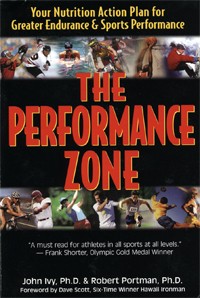The Performance Zone
|

|
| Author: |
Ivy J, Portman R |
| Category: |
Sports Nutrition |
| Audience: |
Elite Athlete |
| Length: |
133 pages |
| Publisher: |
Basic Health Publications, Inc. |
| Year Published: |
2004 |
| List Price: |
$10.95 |
|
|
|
|
AthleteInMe.com®
Rating:



 Excellent!
Excellent!
The Performance Zone is a sports nutrition book. • Recommended for: weekend warriors, serious athletes, both endurance athletes, and strength athletes.
ABOUT THE AUTHORS
• John Ivy, PhD, is chairman of the department of kinesiology and health education at U. Texas (Austin). He is an expert on the topic of sports nutrition. He received his PhD in exercise physiology and has published over 150 papers on the effects of nutrition on physical performance and exercise recovery.
• Robert Portman, PhD, is the head of research at PacificHealth Labs, the company that produces the sports drinks Accelerade® and Endurox-R4®. Portman received his PhD in biochemistry.
CONTENT
The book contains 8 chapters:
- Chapter 1: The Performance Zone
- Chapter 2: Working Muscles
- Chapter 3: Fueling Muscles Before and During Exercise
- Chapter 4: Muscle Recovery After Exercise
- Chapter 5: Fueling Muscles After Exercise
- Chapter 6: Your Nutrition Action Plan
- Chapter 7: Sport-Specific Nutrition Tips
- Chapter 8: Nutritional Supplements and Drugs
REVIEW Ivy and Portman offer 2 fundamental reasons why sports drinks composed of carbs+protein are superior to carbohydrate-only sports drinks: (a) enhanced performance and (b) enhanced recovery.
The basic concept is that supplying carbs combined with protein produces a more dramatic insulin surge, which, in turn, is the key step in building muscle strength and recovery. The authors also state that, in order for this to occur, it is important to supply these nutrients within 45 minutes (preferably, within 15-30 minutes) after strenuous exercise stops. Thus, The Performance Zone explains the concept of "nutrient timing", which is the title of another book by authors Ivy and Portman.
In general the book is easy to read...though, some concepts may be too complex for some readers. For example, while the explanation of muscle energy systems is the best I have read, it may be too technical for readers who do not have some basic understanding of human physiology.
The authors support the text with lots of graphs, but these would be easier to comprehend if they weren't done in a 3-dimensional style, particularly the ones where a linear graph is plotted on top of a 3-D background. Figure 3.2 is confusing because it describes research conducted in cyclists, yet the background image is that of track runners.
The side bar information ("Nutrition Focus") throughout the text is helpful and the authors have enlisted some leading researchers in the field of sports nutrition to contribute this information. Chapter 7, "Sport-Specific Nutrition Tips", is a nice touch, but the authors left out highly-aerobic sports like cross-country skiing, racquetball, tennis, and volleyball. This section could have been improved by including some calorie-expenditure calculations, thereby reinforcing the concepts that were nicely reviewed in Chapter 6.
Chapter 8 should have been deleted. Twelve pages is not nearly enough space to cover vitamins, supplements, and performance-enhancing substances. While this material may be consistent with the title of the book (ie., "performance"), it is generally extraneous content. • What Could Be Better: The only problem I have with this book is the possibility of a
conflict-of-interest. One wonders how this book evolved: ie., Did
PacificHealth Labs fund this research? With one of the 2 authors being
an employee of PacificHealth Labs, was the editing of the manuscript
unbiased? Further, what is the financial relationship (if any) between
Ivy and PacificHealth Labs? (ie., stock ownership or other). This
should have been clarified on the About The Authors page.
Few readers will be concerned about this issue. But, medical
publishers are very sensitive to financial relationships that might
undermine the credibility of scientific research. Leading medical
journals like the New England Journal of Medicine and JAMA require authors to disclose any and all financial relationships that might be perceived as a conflict-of-interest. Although The Performance Zone is not a scientific resource on par with the NEJM or JAMA, it is, nonetheless, written by scientists, and is written in a scientific style.
Thus, I feel that principles that apply to medical publishing should
also apply to this book. In fact, Ivy and Portman seem to agree when
they state in the Introduction (p. 1) that sports nutrition information
"is often colored by marketing hype...". This issue becomes even more
relevant because Ivy and Portman repeatedly state that a
carbohydrate:protein ratio of 4:1 is optimum while Chris Carmichael
states in his book Food For Fitness
(2004) that the optimum ratio is 7:1. Thus, athletes have
substantially differing recommendations from 2 very highly reputable
sources.
SUMMARY
Despite my concerns about potential bias, I can still recommend this book highly. The Performance Zone is a succinct summary of what will certainly be regarded as a new way of looking at sports nutrition during vigorous exercise. This book is a must-read for all coaches, athletic trainers, personal trainers, and serious athletes.
Quite simply, this is one of the best sports nutrition books I have read. Even though there are only 116 pages of text, there is more useable information here than books that are twice as long.
Other Books Similar To This One:
Copyright ©2005 AthleteInMe, LLC. All rights reserved.
| Reviewed by: Stan Reents, PharmD |
6/2/2014 11:59:20 AM |
|